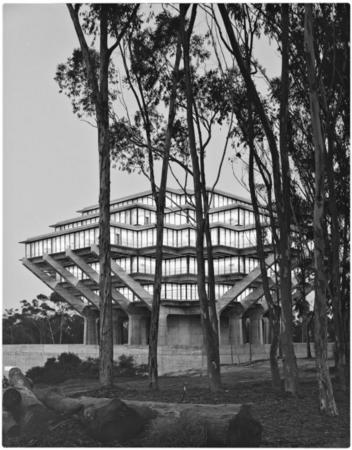The original plans for the college system at UCSD are threatened by rising student numbers.
Over the past ten years, national college acceptance rates have decreased by about 40 percent. One of the reasons that schools have become more selective is that there are more students applying for colleges than there were before. Colleges and universities have to decide how to accommodate the sudden increase of university-aged students. For a university like UC San Diego that operates on a multi-college system, how will the increase of students impact the faculty, quality of education, and student life?
After the end of World War II, the increase in college attendance more than doubled from the year 1950 to the 1970s. Federal government also saw an increased interest in education with the Higher Education Act of 1965 under President Lyndon B. Johnson, which helped create schools and universities.
As noted in the draft proposal for a center of higher education in San Diego, the demand for a generation of skilled workers was placed upon “universities by a changing, increasingly technological society” as the population of the country increased with baby boomers and immigrants.
California was a rapidly growing state at the time of the Higher Education Act, and the “need for additional centers of public higher education” was recognized by the San Diego City Council in a response letter to a university proposal in the area. At the time, the Scripps Institution of Oceanography had been doing research and training graduate students for almost half a century. The new plan was to expand inland with a university that provided graduate studies in science and technology in the San Diego area.
Meanwhile, the president of the University of California at the time, Clark Kerr, had sent a team of researchers to study the college systems in English schools. To study the effects of the college system on undergraduate education, UCSD was granted permission by the UC Board of Regents to implement this college system in 1964. Roger Revelle College became the first established college at UCSD.
UCSD describes its college system as unique among the UC campuses for “providing students with the advantages of a small liberal arts college and the resources of a large research university.”
The creators of the college system hoped that the separation yet integration of departments and individual home colleges would make faculty planning more interdisciplinary and “increase creative contributions” from the faculty. Even though the college system was built for faculty, faculty success in integrating students’ engagement and participation would increase student retention and indirectly benefit the students.
In the 1965 Academic Plan for UCSD, the small faculty to student ratio would “permit economical capital and limit operating costs.” In regard to faculty to student sizes, the ratio was 12-to-1 in the 1980s and is currently a ratio of 15-to-1. The campus has managed to keep an intimate relationship between professors and students, living up to its promise of a liberal arts education which tends to have small class sizes. However, the ratio is only for upper division classes; lower division courses have class sizes up to 100 students per professor.
When the colleges were first established at UCSD, the curriculum offered was 40-percent natural sciences, 25-percent social sciences, 10-percent humanities and arts, and 10-percent other.
Read more:
A Triton is Born
Riding into the Future
Breaking the Glass Ceiling at UCSD
Critics of the early days of the college system, such as Chancellor Herbert F. York and John S. Galbraith, argued that a more humanitarian curriculum needed to be inputted. As a science, technology, engineering, and math school, the university’s early mission was to “provide graduate programs in the sciences and technology, with such undergraduate instruction as is essential to support the graduate programs.” However, York suggested that other areas of study such as philosophy and social sciences needed to be included in the curriculum in order to produce “well-rounded” students.
Galbraith, one of the researchers who was sent to England by Kerr and who would later become the second chancellor of UCSD, commented that the school was a “science institute with a humanities tail.”
This still rings true for students at UCSD today. One anonymous Eleanor Roosevelt College senior said, “Certain colleges make it easier for certain students. The school needs to even out the GEs for the different colleges. Some students have to take more GEs before they can graduate than students from certain colleges.”
In the original letter proposed to the UC Regents in 1965, UCSD’s plan was to create 12 colleges with a maximum of 2,400 students in each. However, over the course of 20 years, the number of students has more than doubled with six colleges accommodating roughly 35,000 students. As of right now, Seventh College is planned to be established within the next two years, and plans for Eighth College and Ninth College are already underway. UCSD has received more applicants that it has ever seen, and the number of admitted students increases with each passing year.
The increase in student population is a concern for the community, student life, and environment of each college.
The current issue regarding universities is the attention and resources directed toward a large, growing student body.
Among current students, opinions vary on UCSD’s college system. The most negative comments regard the living situations of on-campus housing students. Some students agree that the small community makes it easier to meet new people with the same interests within their college. However, some students are concerned with the population growth of the number of students in a college.
One Thurgood Marshall College freshman commented on the housing situation on campus, “I’m in Marshall but I live in Revelle because there was an overflow of students.”
The living arrangements of on-campus housing for undergraduates has become a huge problem in recent years in regard to the quality of the housing and the quantity of people in them.
As one Sixth College freshman points out, “they’ve converted the double rooms in Sixth College to triple rooms,” in an effort to accommodate more students while the other colleges are being built.
This is not the first time the university has expanded to deal with population inflation in the colleges. Fourth College — now Earl Warren College — was created in 1974 to help bring down the 10,000 students enrolled in the other three colleges.
In a 1964 letter to the Committee on Education Policy, UCSD administration said that “a new college would have to be built every 2.5 years” in order to “plateau the increase of students and ease tension off existing colleges.”
While many students believe that the college system at UCSD will last, they think that changes have to be made in order to keep the system strong. However, an even bigger change is looming in the near future. As population trends are projected to change within the next few decades, UCSD may see that its colleges will house less people as the population of aging adults and seniors increases while the number of children and young adults decreases.
Special thanks to the library staff in the Special Collections Room in Geisel Library. Records can be found in the Campus Planning Folders in the University Archives.
Photo courtesy of Oliver Asis.







